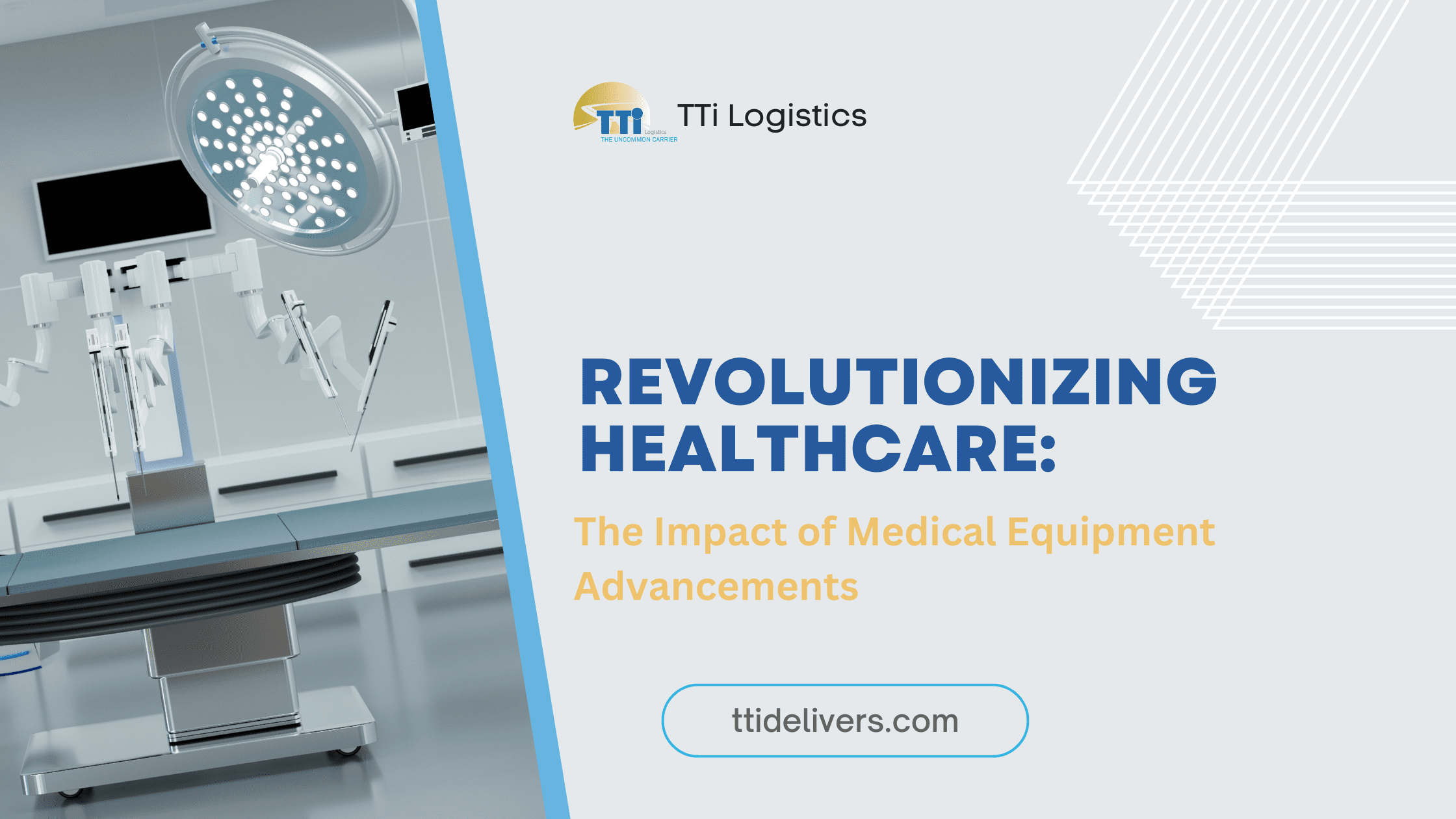Supporting the Future of Healthcare Through Reliable Equipment Logistics
In the ever-evolving landscape of healthcare, technological innovations have continually propelled the industry forward, revolutionizing patient care and reshaping medical practices. At the forefront of these innovations stands medical equipment, a cornerstone of modern healthcare delivery, facilitating diagnosis, treatment, and patient monitoring. This comprehensive exploration delves deeply into the realm of medical equipment, tracing its evolution, delineating its applications, addressing pertinent challenges, highlighting its profound influence on the healthcare landscape, and envisaging its future trajectory.
Introduction to Medical Equipment
Medical equipment constitutes a diverse array of devices, instruments, and machinery employed across healthcare settings to diagnose, treat, and monitor medical conditions. Spanning from sophisticated diagnostic imaging systems and precision surgical tools to advanced patient monitoring devices and therapeutic equipment, medical equipment encompasses a broad spectrum of tools meticulously designed to support healthcare professionals in delivering optimal care to patients.
Across centuries, medical equipment has undergone remarkable evolution, propelled by relentless advances in technology, materials science, and biomedical engineering. These strides have not only augmented the precision and efficacy of medical procedures but have also democratized healthcare access, rendering it more efficient, accessible, and patient-centric.
Historical Evolution of Medical Equipment
The roots of medical equipment trace back to antiquity when rudimentary implements were utilized for surgical interventions and diagnostic endeavors. Early civilizations crafted crude surgical tools from stone, bone, and metal, employing them in rudimentary medical procedures.
Advancements in medical equipment accelerated during the Renaissance period, spurred by renewed interest in anatomy, physiology, and scientific inquiry. Pioneering figures such as Leonardo da Vinci conceptualized innovative surgical instruments and anatomical drawings that laid the groundwork for future medical innovations.
The industrial revolution of the 18th and 19th centuries ushered in an era of unprecedented technological progress, fueling the development of novel medical devices and instruments. Innovations such as the stethoscope, invented by René Laennec in 1816, and the ophthalmoscope, devised by Hermann von Helmholtz in 1851, revolutionized medical diagnosis and ushered in the era of modern medical instrumentation.
The Modern Era of Medical Equipment
The 20th century witnessed a seismic shift in medical equipment technology, driven by rapid advancements in electronics, materials science, and imaging technology. Breakthroughs such as the discovery of X-rays by Wilhelm Conrad Roentgen in 1895 and the development of the first practical ultrasound scanner by Ian Donald in the 1950s transformed diagnostic imaging, enabling non-invasive visualization of internal structures with unprecedented clarity.
Moreover, the advent of minimally invasive surgical techniques, facilitated by innovations such as laparoscopy and endoscopy, revolutionized surgical practice, reducing patient trauma, accelerating recovery times, and enhancing surgical outcomes. The introduction of robotic-assisted surgical systems in the early 21st century further expanded the capabilities of minimally invasive surgery, enabling surgeons to perform complex procedures with enhanced precision and control.
Applications of Medical Equipment
Medical equipment serves a multifaceted role in modern healthcare, embracing a myriad of applications across various medical specialties. Some key applications include:
- Diagnostic Imaging:
- Cutting-edge imaging modalities such as X-rays, CT scans, MRI, and ultrasound facilitate non-invasive visualization of internal structures, facilitating the detection and diagnosis of diverse pathologies.
- Surgical Equipment:
- Surgical instruments, ranging from scalpels and forceps to advanced robotic-assisted systems, enable precise and minimally invasive surgical interventions, thereby minimizing patient discomfort and accelerating recovery.
- Patient Monitoring Devices:
- Vital sign monitoring devices, encompassing electrocardiography (ECG) monitors, pulse oximeters, and blood pressure monitors, enable continuous surveillance of patients’ physiological parameters, enabling prompt detection of complications and timely intervention.
- Therapeutic Equipment:
- Therapeutic devices such as ventilators, infusion pumps, and dialysis machines deliver life-sustaining treatments to patients with acute or chronic conditions, playing a pivotal role in critical care settings.
- Rehabilitation and Assistive Devices:
- Rehabilitation aids, including mobility aids, prosthetics, and orthoses, facilitate the rehabilitation and reintegration of individuals with physical disabilities, enhancing their mobility and quality of life.
Emerging Trends and Innovations in Medical Equipment
The landscape of medical equipment is continually evolving, driven by ongoing innovations and technological advancements. Several emerging trends and innovations are poised to shape the future of medical equipment, including:
- Artificial Intelligence (AI) in Medical Imaging: AI algorithms are increasingly being integrated into medical imaging systems to analyze imaging data, detect anomalies, and assist healthcare professionals in diagnosis and treatment planning. AI-driven image analysis holds promise for improving diagnostic accuracy and efficiency while reducing interpretation time.
- 3D Printing in Medical Device Manufacturing: 3D printing technology enables the rapid prototyping and fabrication of complex medical devices, including implants, prosthetics, and surgical instruments. The ability to customize medical devices to individual patient anatomy enhances treatment outcomes and patient satisfaction.
- Wearable Medical Devices and Remote Monitoring: Wearable medical devices equipped with sensors and connectivity capabilities enable continuous monitoring of vital signs and health metrics outside traditional clinical settings. Remote monitoring technologies facilitate real-time data transmission to healthcare providers, enabling early detection of health issues and timely intervention.
- Nanotechnology in Therapeutic Applications: Nanotechnology holds promise for revolutionizing therapeutic interventions by enabling targeted drug delivery, imaging contrast enhancement, and tissue regeneration. Nanoscale devices and materials offer precise control over therapeutic interactions, minimizing side effects and improving treatment efficacy.
Challenges and Considerations
Despite the remarkable strides in medical equipment, several challenges persist, impacting its adoption, accessibility, and efficacy:
- Cost and Affordability:
- The substantial cost associated with medical equipment acquisition, maintenance, and operation poses financial constraints for healthcare providers and patients alike, particularly in resource-constrained settings.
- Regulatory Compliance:
- Medical equipment is subject to stringent regulatory standards and requirements to ensure safety, efficacy, and quality. Navigating the complex regulatory landscape can be arduous, leading to delays in innovation and market entry.
- Technological Complexity:
- The escalating complexity of medical equipment, particularly advanced imaging and therapeutic devices, necessitates specialized training and expertise for healthcare professionals, posing challenges in adoption and utilization.
- Interoperability and Integration:
- Medical equipment often operates within intricate healthcare ecosystems, mandating seamless interoperability and integration with electronic health records and other healthcare IT systems to facilitate data exchange and collaboration.
TTi Logistics: Empowering Healthcare with Efficient Medical Equipment Logistics
At TTi Logistics, we recognize the pivotal role of medical equipment in healthcare delivery and are steadfast in our commitment to supporting the industry with tailored logistics solutions. From warehousing and inventory management to transportation and installation, our comprehensive logistics services ensure the secure, efficient, and punctual delivery of medical equipment to its intended destination.
With a seasoned team of logistics professionals adept in handling diverse medical equipment, including diagnostic imaging systems, surgical instruments, patient monitoring devices, and therapeutic equipment, we collaborate closely with our clients to develop bespoke logistics strategies aligned with their specific needs and regulatory requirements.
Whether it involves delivering a cutting-edge MRI machine to a hospital, installing a state-of-the-art robotic surgical system in an operating theater, or replenishing essential medical device supplies in a healthcare facility, TTi Logistics remains unwavering in our commitment to supporting healthcare providers and manufacturers in their mission to provide superior patient care and improve health outcomes.
The Future of Medical Equipment
Looking ahead, the future of medical equipment is imbued with promise, propelled by ongoing advancements in technology, innovation, and healthcare delivery models. Emerging technologies such as artificial intelligence (AI), 3D printing, and telemedicine are poised to revolutionize the design, manufacturing, and utilization of medical equipment, ushering in an era of personalized, precise, and accessible healthcare.
Artificial intelligence, in particular, holds transformative potential in medical diagnostics and decision-making, leveraging machine learning algorithms to analyze medical imaging data, discern patterns, and aid healthcare professionals in diagnosis and treatment planning. Similarly, 3D printing technologies offer unparalleled opportunities for customization and on-demand fabrication of patient-specific implants, prosthetics, and surgical instruments, revolutionizing personalized medicine and surgical care.
Moreover, the integration of telemedicine and remote monitoring technologies facilitates healthcare delivery beyond traditional clinical confines, empowering patients to manage their health and well-being from the comfort of their homes. Wearable devices, mobile applications, and telehealth platforms facilitate remote consultations, real-time monitoring, and virtual care delivery, enhancing healthcare access and optimizing patient outcomes.
Charting the Future Course of Medical Equipment in Healthcare
This comprehensive discourse on medical equipment spans the historical trajectory, contemporary applications, emerging trends, challenges, logistical considerations, and future prospects of this indispensable component of modern healthcare delivery. With each technological innovation and logistical endeavor, the healthcare landscape evolves, propelled by a shared commitment to excellence, accessibility, and patient-centric care. As we navigate the ever-expanding frontiers of medical equipment, the pursuit of innovation and the optimization of patient outcomes remain paramount, underpinned by unwavering dedication and collaborative partnerships.







